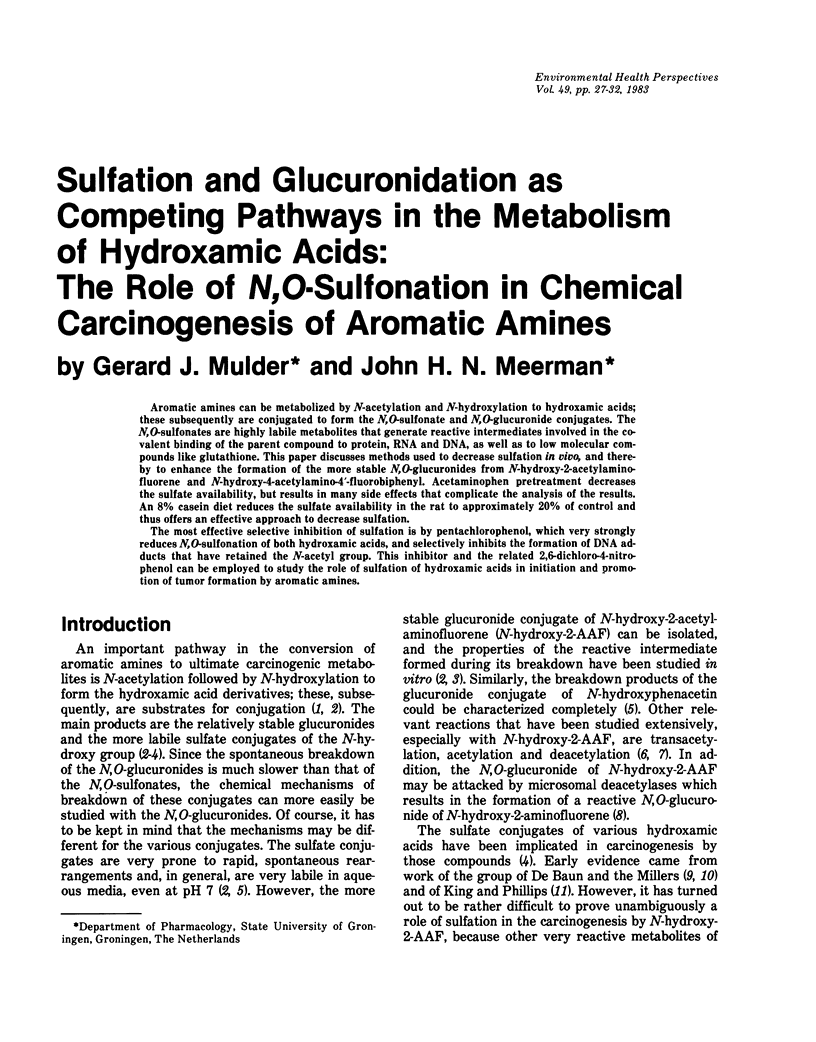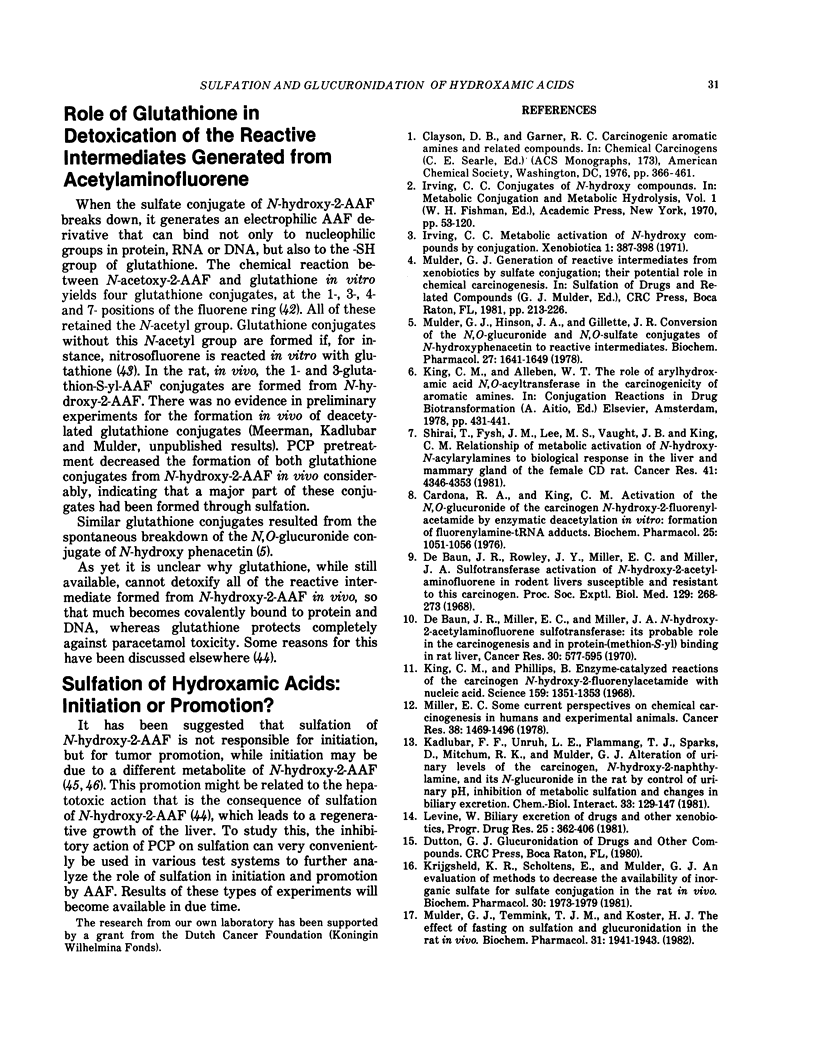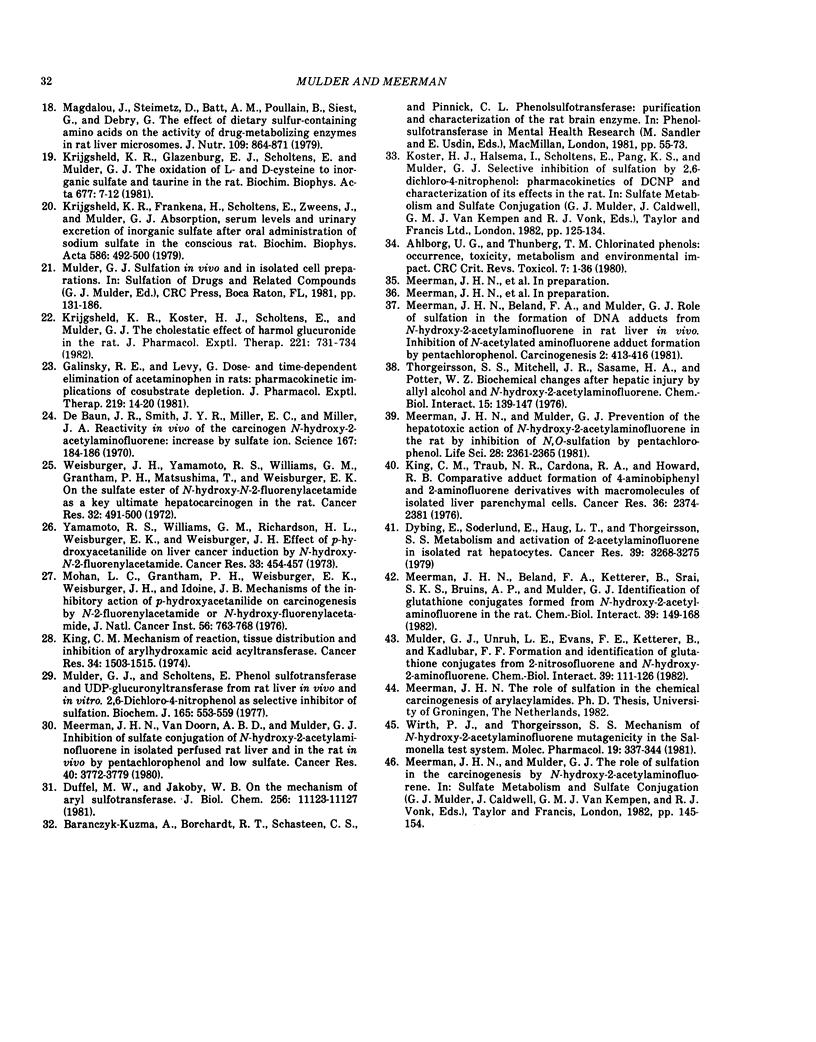Abstract
Aromatic amines can be metabolized by N-acetylation and N-hydroxylation to hydroxamic acids; these subsequently are conjugated to form the N,O-sulfonate and N,O-glucuronide conjugates. The N,O-sulfonates are highly labile metabolites that generate reactive intermediates involved in the covalent binding of the parent compound to protein, RNA and DNA, as well as to low molecular compounds like glutathione. This paper discusses methods used to decrease sulfation in vivo, and thereby to enhance the formation of the more stable N,O-glucuronides from N-hydroxy-2-acetylaminofluorene and N-hydroxy-4-acetylamino-4'-fluorobiphenyl. Acetaminophen pretreatment decreases the sulfate availability, but results in many side effects that complicate the analysis of the results. An 8% casein diet reduces the sulfate availability in the rat to approximately 20% of control and thus offers an effective approach to decrease sulfation. The most effective selective inhibition of sulfation is by pentachlorophenol, which very strongly reduces N,O-sulfonation of both hydroxamic acids, and selectively inhibits the formation of DNA adducts that have retained the N-acetyl group. This inhibitor and the related 2,6-dichloro-4-nitrophenol can be employed to study the role of sulfation of hydroxamic acids in initiation and promotion of tumor formation by aromatic amines.
Full text
PDF





Selected References
These references are in PubMed. This may not be the complete list of references from this article.
- Ahlborg U. G., Thunberg T. M. Chlorinated phenols: occurrence, toxicity, metabolism, and environmental impact. Crit Rev Toxicol. 1980 Jul;7(1):1–35. doi: 10.3109/10408448009017934. [DOI] [PubMed] [Google Scholar]
- Cardona R. A., King C. M. Activation of the O-glucuronide of the carcinogen N-hydroxy-N-2-fluorenylacetamide by enzymatic deacetylation in vitro: formation of fluorenylamine-tRNA adducts. Biochem Pharmacol. 1976 May 1;25(9):1051–1056. doi: 10.1016/0006-2952(76)90495-0. [DOI] [PubMed] [Google Scholar]
- DeBaun J. R., Miller E. C., Miller J. A. N-hydroxy-2-acetylaminofluorene sulfotransferase: its probable role in carcinogenesis and in protein-(methion-S-yl) binding in rat liver. Cancer Res. 1970 Mar;30(3):577–595. [PubMed] [Google Scholar]
- DeBaun J. R., Rowley J. Y., Miller E. C., Miller J. A. Sulfotransferase activation of N-hydroxy-2-acetylaminofluorene in rodent livers susceptible and resistant to this carcinogen. Proc Soc Exp Biol Med. 1968 Oct;129(1):268–273. doi: 10.3181/00379727-129-33301. [DOI] [PubMed] [Google Scholar]
- DeBaun J. R., Smith J. Y., Miller E. C., Miller J. A. Reactivity in vivo of the carcinogen N-hydroxy-2-acetylaminofluorene: increase by sulfate ion. Science. 1970 Jan 9;167(3915):184–186. doi: 10.1126/science.167.3915.184. [DOI] [PubMed] [Google Scholar]
- Duffel M. W., Jakoby W. B. On the mechanism of aryl sulfotransferase. J Biol Chem. 1981 Nov 10;256(21):11123–11127. [PubMed] [Google Scholar]
- Dybing E., Søderlund E., Haug L. T., Thorgeirsson S. S. Metabolism and activation of 2-acetylaminofluorene in isolated rat hepatocytes. Cancer Res. 1979 Aug;39(8):3268–3275. [PubMed] [Google Scholar]
- Galinsky R. E., Levy G. Dose- and time-dependent elimination of acetaminophen in rats: pharmacokinetic implications of cosubstrate depletion. J Pharmacol Exp Ther. 1981 Oct;219(1):14–20. [PubMed] [Google Scholar]
- Irving C. C. Metabolic activation of N-hydroxy compounds by conjugation. Xenobiotica. 1971 Jul-Oct;1(4):387–398. doi: 10.3109/00498257109041505. [DOI] [PubMed] [Google Scholar]
- Kadlubar F. F., Unruh L. E., Flammang T. J., Sparks D., Mitchum R. K., Mulder G. J. Alteration of urinary levels of the carcinogen, N-hydroxy-2-naphthylamine, and its N-glucuronide in the rat by control of urinary pH, inhibition of metabolic sulfation, and changes in biliary excretion. Chem Biol Interact. 1981 Jan;33(2-3):129–147. doi: 10.1016/0009-2797(81)90036-3. [DOI] [PubMed] [Google Scholar]
- King C. M. Mechanism of reaction, tissue distribution, and inhibition of arylhydroxamic acid acyltransferase. Cancer Res. 1974 Jun;34(6):1503–1515. [PubMed] [Google Scholar]
- King C. M., Phillips B. Enzyme-catalyzed reactions of the carcinogen N-hydroxy-2-fluorenylacetamide with nucleic acid. Science. 1968 Mar 22;159(3821):1351–1353. doi: 10.1126/science.159.3821.1351. [DOI] [PubMed] [Google Scholar]
- King C. M., Traub N. R., Cardona R. A., Howard R. B. Comparative adduct formation of 4-aminobiphenyl and 2-aminofluorene derivatives with macromolecules of isolated liver parenchymal cells. Cancer Res. 1976 Jul;36(7 Pt 1):2374–2381. [PubMed] [Google Scholar]
- Krijgsheld K. R., Frankena H., Scholtens E., Zweens J., Mulder G. J. Absorption, serum levels and urinary excretion of inorganic sulfate after oral administration of sodium sulfate in the conscious rat. Biochim Biophys Acta. 1979 Sep 3;586(3):492–500. doi: 10.1016/0304-4165(79)90039-4. [DOI] [PubMed] [Google Scholar]
- Krijgsheld K. R., Glazenburg E. J., Scholtens E., Mulder G. J. The oxidation of L- and D-cysteine to inorganic sulfate and taurine in the rat. Biochim Biophys Acta. 1981 Sep 18;677(1):7–12. doi: 10.1016/0304-4165(81)90139-2. [DOI] [PubMed] [Google Scholar]
- Krijgsheld K. R., Koster H. J., Scholtens E., Mulder G. J. Cholestatic effect of harmol glucuronide in the rat. Prevention of harmol-induced cholestasis by increased formation of harmol sulfate. J Pharmacol Exp Ther. 1982 Jun;221(3):731–734. [PubMed] [Google Scholar]
- Krujgsheld K. R., Scholtens E., Mulder G. J. An evaluation of methods to decrease the availability of inorganic sulphate for sulphate conjugation in the rat in vivo. Biochem Pharmacol. 1981 Jul 15;30(14):1973–1979. doi: 10.1016/0006-2952(81)90208-2. [DOI] [PubMed] [Google Scholar]
- Magdalou J., Steimetz D., Batt A. M., Poullain B., Siest G., Debry G. The effect of dietary sulfur-containing amino acids on the activity of drug-metabolizing enzymes in rat-liver microsomes. J Nutr. 1979 May;109(5):864–871. doi: 10.1093/jn/109.5.864. [DOI] [PubMed] [Google Scholar]
- Meerman J. H., Beland F. A., Ketterer B., Srai S. K., Bruins A. P., Mulder G. J. Identification of glutathione conjugates formed from N-hydroxy-2-acetylaminofluorene in the rat. Chem Biol Interact. 1982 Mar 15;39(2):149–168. doi: 10.1016/0009-2797(82)90118-1. [DOI] [PubMed] [Google Scholar]
- Meerman J. H., Beland F. A., Mulder G. J. Role of sulfation in the formation of DNA adducts from N-hydroxy-2-acetylaminofluorene in rat liver in vivo. Inhibition of N-acetylated aminofluorene adduct formation by pentachlorophenol. Carcinogenesis. 1981;2(5):413–416. doi: 10.1093/carcin/2.5.413. [DOI] [PubMed] [Google Scholar]
- Meerman J. H., Mulder G. J. Prevention of the hepatotoxic action of N-hydroxy-2-acetylaminofluorene in the rat by inhibition of N-O-sulfation by pentachlorophenol. Life Sci. 1981 May 21;28(21):2361–2365. doi: 10.1016/0024-3205(81)90501-4. [DOI] [PubMed] [Google Scholar]
- Meerman J. H., van Doorn A. B., Mulder G. J. Inhibition of sulfate conjugation of N-hydroxy-2-acetylaminofluorene in isolated perfused rat liver and in the rat in vivo by pentachlorophenol and low sulfate. Cancer Res. 1980 Oct;40(10):3772–3779. [PubMed] [Google Scholar]
- Miller E. C. Some current perspectives on chemical carcinogenesis in humans and experimental animals: Presidential Address. Cancer Res. 1978 Jun;38(6):1479–1496. [PubMed] [Google Scholar]
- Mohan L. C., Grantham P. H., Weisburger E. K., Weisburger J. H., Idoine J. B. Mechanisms of the inhibitory action of p-hydroxyacetanilide on carcinogenesis by N-2-fluorenylacetamide or N-hydroxy-N-2-fluorenylacetamide. J Natl Cancer Inst. 1976 Apr;56(4):763–768. doi: 10.1093/jnci/56.4.763. [DOI] [PubMed] [Google Scholar]
- Mulder G. J., Hinson J. A., Gillette J. R. Conversion of the N-Q-glucuronide and N-O-sulfate conjugates of N-hydroxyphenacetin to reactive intermediates. Biochem Pharmacol. 1978;27(12):1641–1649. doi: 10.1016/0006-2952(78)90173-9. [DOI] [PubMed] [Google Scholar]
- Mulder G. J., Scholtens E. Phenol sulphotransferase and uridine diphosphate glucuronyltransferase from rat liver in vivo and vitro. 2,6-Dichloro-4-nitrophenol as selective inhibitor of sulphation. Biochem J. 1977 Sep 1;165(3):553–559. doi: 10.1042/bj1650553. [DOI] [PMC free article] [PubMed] [Google Scholar]
- Mulder G. J., Temmink T. J., Koster H. J. The effect of fasting on sulfation and glucuronidation in the rat in vivo. Biochem Pharmacol. 1982 May 15;31(10):1941–1944. doi: 10.1016/0006-2952(82)90502-0. [DOI] [PubMed] [Google Scholar]
- Shirai T., Fysh J. M., Lee M. S., Vaught J. B., King C. M. Relationship of metabolic activation of N-hydroxy-N-acylarylamines to biological response in the liver and mammary gland of the female CD rat. Cancer Res. 1981 Nov;41(11 Pt 1):4346–4353. [PubMed] [Google Scholar]
- Thorgeirsson S. S., Mitchell J. R., Sasame H. A., Potter W. Z. Biochemical changes after hepatic injury by allyl alcohol and N-hydroxy-2-acetylaminofluorene. Chem Biol Interact. 1976 Oct 2;15(2):139–147. doi: 10.1016/0009-2797(76)90159-9. [DOI] [PubMed] [Google Scholar]
- Weisburger J. H., Yamamoto R. S., Williams G. M., Grantham P. H., Matsushima T., Weisburger E. K. On the sulfate ester of N-hydroxy-N-2-fluorenylacetamide as a key ultimate hepatocarcinogen in the rat. Cancer Res. 1972 Mar;32(3):491–500. [PubMed] [Google Scholar]
- Wirth P. J., Thorgeirsson S. S. Mechanism of N-hydroxy-2-acetylaminofluorene mutagenicity in the Salmonella test system. Role of N-O acyltransferase and sulfotransferase from rat liver. Mol Pharmacol. 1981 Mar;19(2):337–344. [PubMed] [Google Scholar]
- Yamamoto R. S., Williams G. M., Richardson H. L., Weisburger E. K., Weisburger J. H. Effect of p-hydroxyacetanilide on liver cancer induction by N hydroxy-N-2-fluorenylacetamide. Cancer Res. 1973 Mar;33(3):454–457. [PubMed] [Google Scholar]


